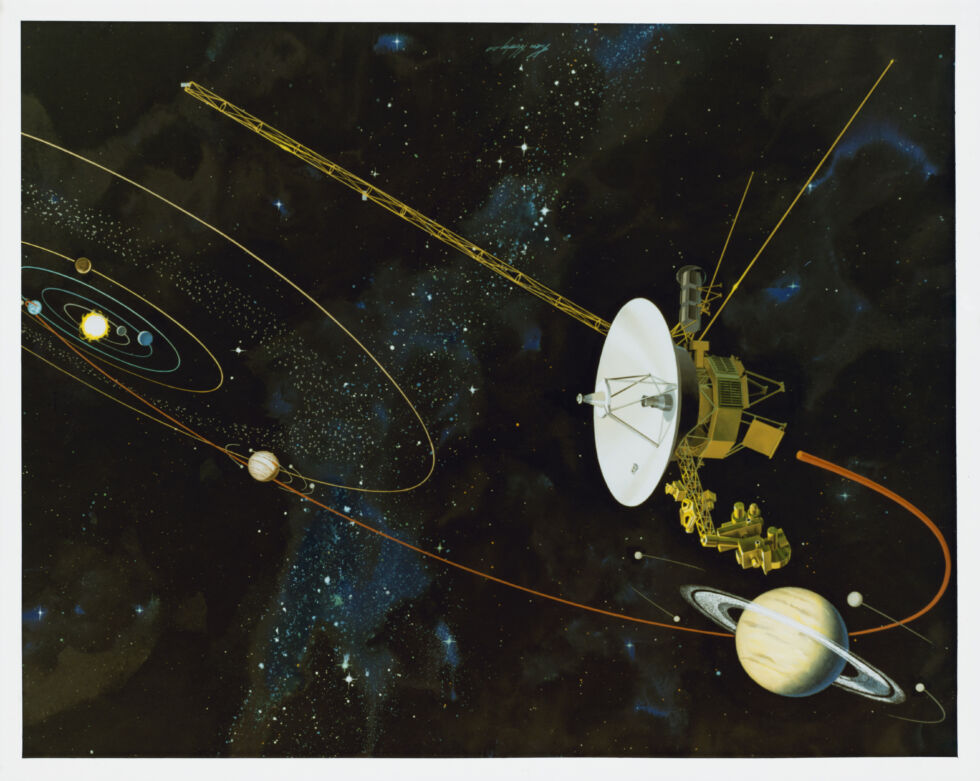What if we dropped interstellar ambitions and focused on understanding our home system?
Key takeaways
- Voyager 1 became the first human-made object to enter interstellar space on August 25, 2012, symbolizing humanity’s reach beyond the Solar System.
- Sustained travel between stars is currently beyond our technological capabilities due to the vast distances involved.
- Instead of chasing distant stars, we should concentrate on exploring and understanding the mysteries of our own Solar System, which holds many secrets.
- With adequate funding, we can send robotic missions throughout the Solar System to answer significant scientific questions about planets, moons, and other celestial bodies.
- The Solar System offers numerous opportunities for discovery, from the clouds of Venus to the icy oceans of Europa, which can be explored within the next century.
On August 25, 2012, humankind became an interstellar species. There was no hoopla or cosmic welcoming party when a simple robotic probe, the Voyager 1 spacecraft, passed an unseen frontier. It slid between the zone controlled by the Sun’s physics and the thin plasma environment between the stars.
Whatever fate awaits us now, whatever future civilizations emerge and collapse, whether we heal the Earth or continue on our self-destructive course, we will always have this. A memorial, a signpost, a tribute to our species’ existence and mental brilliance. It seems doubtful that any extraterrestrial civilization would intercept our spaceship, but it will continue to exist for millennia, orbiting the center of the Milky Way.
In the next decades, Voyager 1 will be joined by other spacecraft on solar-escape missions, including the Pioneer probes and New Horizons. And now that we’ve crossed this astrophysical boundary, we must confront a painful question: Is this it? Is this all we’ll ever achieve outside the Solar System, a scattering of errant probes launched into the limitless night?
For decades, scientists, engineers, and visionaries have toiled to create technologies that would significantly expand human presence outside the Solar System. But they all confront the same great challenge: the mind-boggling size of the universe. Sustained interstellar travel is clearly beyond the capabilities of our current technology and any plausible forecast of what we will create in the next decades.
Thankfully, this does not imply that our space ambitions are over. We’ll have to learn to love the person we’re with, stop seeking beyond unreachable boundaries, and instead focus our curious eyes and brains on the beauties and mysteries of our own Solar System.
The slow way
To put the difficulties of interplanetary travel into context, let’s create a scale model of our local neighborhood. Find a few willing participants (friends, family, sleeping animals, anything). Place one in the center of the room—this is the Sun. Place yourself as the Earth and stand three feet away from them. That is our Solar System, with the three feet symbolizing the 93 million miles between our planet and the star.
Your second volunteer will be Proxima Centauri, the Sun’s closest star at 4.246 light years distant. Our use of light-years as a measurement here obscures the full magnitude of the distance, hiding it away inside a word that is truly beyond comprehension rather than allowing us to grasp what the numbers represent. To gain that appreciation, conduct a game with your second volunteer: ask them to place themselves where they believe Proxima should be on the scale model.
Then pack them a meal and toss them in the car since they have almost 200 miles to drive.
The Voyager 1 probe has been playing a real-life version of this. The spacecraft was launched on September 5th, 1977, and arrived to Neptune, the Solar System’s outermost sentinel, more than a decade later.

Since then, it has not encountered another world.
Voyager 1 is fast enough to transcend the gravitational pull of the Sun. Except for a weird cosmic catastrophe, it’ll never return. Cruising at nearly 56,000 kilometers per hour (35,000 mph), it could circumnavigate the Earth in less than 45 minutes and crossed the heliopause after around 35 years of transit time. The heliopause is usually regarded as the Solar System’s border, and it is characterized by a significant shift in the density of charged particles that float across space. The inside of the heliopause is dominated by particles coming from the Sun itself; beyond it, you’ll find yourself in a mixture created by billions of distant stars.
In that perspective, interstellar space does not appear to be very far away. It takes just one generation, or a fraction of a human lifetime, to reach the farthest boundaries of our Solar System. However, Voyager’s voyage has only just begun. Beyond the heliopause lies the Oort cloud, a loose sphere of tiny, frozen comets circling the Sun that were scattered during the Solar System’s creation billions of years ago. Those bodies in the Oort cloud live lonely lives, knowing the Sun as merely a point of light that is somewhat brighter than the rest.
The inner border of the Oort cloud is around 2,000 to 5,000 Astronomical Units (AU), or the length of the normal Earth-Sun distance, distant. At its present speed, Voyager will reach that shell of material between 600 to 1,500 years from now, long after it runs out of power.

To put it another way, if the Byzantine emperor Justinian had launched the Taxidiótis probe from his capital in Constantinople in 540 AD, it would just now be nearing the Oort cloud. (Assuming Taxidiótis can achieve equal speeds).
The outer border of the Oort cloud is considerably more unpredictable. Its largest probable extent is almost a light-year. Voyager 1 will have to sail silently for over 20,000 years to reach the opposite side. Not that there will be any possibility of a meeting; the five Earth masses’ worth of material in the Oort cloud is strewn so thinly that collision is almost impossible.
If Voyager were bound for Proxima Centauri—which it is not—it would take around 80,000 years to complete its voyage.
80,000 years. 80,000 years ago, all modern humans lived in Africa, while Neanderthals and Denisovans dominated Europe and Asia. This includes the emergence of abstract language, the evolution of art and music, the beginnings of monumental architecture, the expansion of agriculture, the establishment of cities, and, in the last few thousand years, the resurgence of recorded history. Everything we connect with contemporary humans—our culture, our methods of life, and even our ways of thinking—can be encapsulated in the duration of a single journey to our closest star.
The fastest way
If we wish to journey among the stars, we must first overcome the insurmountable voids that separate us. Let us set aside the thought of sending people on such an expedition anytime soon, if at all. We can’t even send people to Mars, the next closest planet, without significant expenditure to overcome the engineering problems that come with such a mission.
So, for the time being, let us concentrate on robotic probes, as they will suffice for numerous generations. If we want to go to Proxima Centauri rapidly, we have to accelerate our vessel to a substantial percentage of the speed of light.
However, we cannot accomplish these speeds using conventional techniques, such as chemically propelled rockets. One of the most unpleasant parts of space flight is described as the “tyranny of the rocket equation.” To put it simply, more gasoline is required to travel faster or farther. However, when you consume more fuel, you gain weight. So you need even more fuel to counteract that weight, making you heavier. Certain aims, such as traveling to the closest stars in less than a generation, will eventually become unattainable. A bit “really hard.” Impossible.
The Breakthrough Starshot Project is one possible solution to the rocket equation. Yuri Milner, a Soviet-Israeli venture billionaire, has invested $100 million in the initiative, which intends to establish the baseline ideas and technologies required to send a probe to the closest star in less than one human lifetime. While there isn’t nearly enough money to build anything, the goal is that it will establish the framework for future significant funding (likely in the tens of billions of dollars) to complete the project.
To achieve this exceedingly ambitious aim, Starshot’s current plan is to employ a lightsail, which is a spaceship linked to a giant reflecting membrane. The lightsail does not carry any fuel aboard, liberating it from the constraints of the rocket equation. Instead, a massive laser on the ground will be utilized to propel the spaceship. The laser’s radiation has no mass, but it does have momentum, thus by bouncing off the sail, the photons may impart a modest, but not zero, amount of push to the spaceship.

As long as the laser fires, the spacecraft can continue accelerating right up to the edge of the speed of light. The only limiting factor is the power of the laser. And the ability to maintain its focus over large distances. And the reflectivity of the lightsail membrane.
The current reference design for Starshot aims to fire a 100 Gigawatt laser for around ten minutes, accelerating a spaceship to about 10% of the speed of light. At such speed, a Starshot-style probe could pass Proxima Centauri in less than half a century. While that would be the longest spaceflight in human history, it is at least shorter than the average human lifetime, so the same people who launched the probe could possibly see it through to completion—a completion that would entail a high-speed zoom through the Proxima system (don’t even think about slowing down, let alone returning to Earth). It would take another four years to return to Earth with the data it had gathered there.
While this idea is not blatantly impossible, the obstacles in implementing it demonstrate how far mankind needs to go before interplanetary travel becomes as common as intercontinental.
To begin with, the laser requires 100 gigawatts of energy. That is nearly equivalent to the total energy production of all nuclear power plants in the United States combined. There are more powerful lasers out there, reaching petawatts and even zettawatts, but they use less overall energy by shooting for a short period of time—usually around a femtosecond, or 10-15 seconds.
The Starshot laser will need to consume the entire nuclear energy production of the United States and run continuously for around 10 minutes, which is almost a billion billion times longer than we can now maintain such strong laser pulses.
The lightsail material will need to be the most reflecting ever developed. If even a small portion of the laser light is absorbed, it will provide enough energy to melt the lightsail.
This is all assuming that we can precisely direct the laser through our ever-changing environment toward the ever distant, and hence smaller, lightsail. (We’ll also presume that once the world’s most powerful laser is built, it won’t be utilized to take over the globe like Dr. Evil).
To make the math work—the strength of the laser, the size of the lightsail, the maximum speed—the Starshot spacecraft’s size is limited. That limit is around one gram.
For reference, that is around the mass of a paperclip.
The “No” way
Assuming that our species’ collective dream isn’t to flood the Milky Way with paperclips, those tiny spacecraft will have to pack a lot of punch (sensors, communications, controlling electronics, shielding, and a power source for everything) into a small package, which presents its own set of enormous challenges.
However, nothing about Starshot is impossible. It’s just really difficult and expensive, and it will take an undetermined period of time to complete. Humans have previously overcome difficult, possibility-pushing problems.
But Starshot also highlights the unavoidable difficulties of interplanetary travel. We can launch competent, sophisticated, huge spacecraft almost anywhere in the Solar System. Sending humans is primarily an extension of existing technology. Nonetheless, sending a sprinkling of ultra-tiny probes to the nearest few stars in our local neighborhood will necessitate remarkable technological advances, leaving the other hundreds of billions of stars undiscovered.
That isn’t always a terrible thing. Surely, those distant stars contain unfathomable wealth of knowledge that will help us grasp the evolution and fate of stars, the possibility of life on other planets, and much more. But such information comes at a high cost. This provides us an intriguing alternative.
What if we devoted even a small fraction of the time, effort, and money required to complete a quick interstellar expedition instead on comprehending the Solar System?
We have the ability to deploy spacecraft anyplace in the Solar System, if we have the necessary funding. And what we’ve learnt in just a half-century of research has no precedence in human history—something we might easily overlook in our pursuit of intergalactic fantasies. Accelerating this new age of solar discovery will allow us to answer numerous questions that scientists are eager to solve.
The surface of Venus is hot enough to melt lead, yet the upper atmosphere is comfortable. What would we discover if we drifted through its clouds? Mars once had rushing rivers and glittering oceans. What substances and creatures previously swam in its oceans? The deeper depths of the huge planets remain unmapped and unknown, with familiar components acting strangely as they are crushed under pressure. What bizarre physics powers their insides? The outer moons of those giants, such as Europa and Enceladus, have more liquid water than the Earth. What secrets lie under their globe-spanning ice sheets? The asteroid belt, Kuiper belt, and Oort cloud preserve memories of the early Solar System. What can they tell us about our home ancient story?
Our Solar System is both beautiful and enigmatic, with many unknowns. However, it is also accessible. In the next hundred years, we will be able to deploy robotic ships and even human hands to several of these worlds. We can ride comets and explore asteroids’ centers. We can send submersibles into oceans that have never seen the light of the sun. We can fly planes through atmospheres that are harmful to us but may support their own forms of life.
We don’t need to go to faraway stars to discover the Universe’s big secrets. The Universe has brought many of them to our doorstep.


